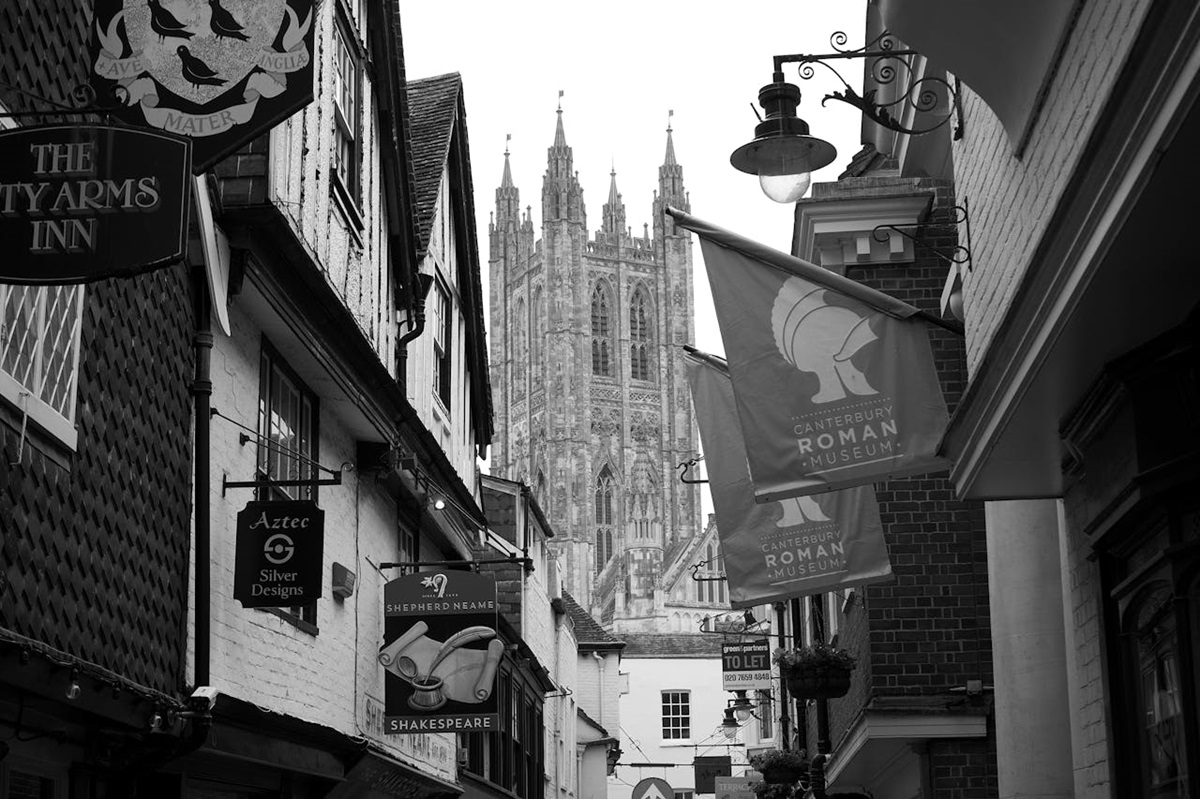Canterbury Cathedral Tours
Canterbury Cathedral overview
One of the main attractions for many first-time visitors to Canterbury is undoubtedly Canterbury Cathedral. This remarkable building is among the oldest Christian structures in England and is a key part of a World Heritage Site.
Canterbury Cathedral serves as the main church for the Archbishop of Canterbury, who is the head of the Church of England and a symbolic figure for the global Anglican Communion.
Canterbury Cathedral has a rich history that goes back even before the establishment of the Church of England. A significant event was the assassination of Thomas à Becket in 1170 by supporters of Henry II, which turned Canterbury into a prominent pilgrimage destination.
The Cathedral, situated right in the heart of the city, is impossible to overlook. It stands directly opposite the convenient tourist office.
Due to the medieval design of Canterbury’s streets, you would have needed to walk a minimum of 5 to 10 minutes from any point in the city to reach the magnificent entrance.
Visiting Canterbury Cathedral

Canterbury, much like Salisbury Cathedral, boasts a beautifully maintained Close surrounding the Cathedral. There are only a handful of gates that connect this sacred space to the bustling city streets. To enter the Cathedral itself, you’ll need to purchase a ticket at the main gate.
If you’re not keen on visiting the Cathedral itself, a great alternative is to join the Canterbury walking tour. This tour takes you through the Close, allowing you to spend plenty of time discovering this beautiful and extensive area.
When visiting Canterbury Cathedral, keep in mind this is primarily a functioning Cathedral not just a tourist attraction. There might be a service, event, or pilgrimage happening during your visit that could influence your experience.
Opening hours
The Cathedral is open seven days a week, from 10am to 5pm Monday to Saturday and 12.30pm to 5pm on Sunday. Last admission is at 4pm. It is worth knowing that these times do change at short notice for funerals, weddings, services and exceptional circumstances.
Currently the Cathedral is opening with reduced capacity with pre-booked ticket entry only. There are also no audio guides at present.
Tours
If you are specifically after a guided tour, we would recommend not going on a Sunday as they do not run on this day. Otherwise tours run three times daily.
40 minute audio tours are available in several languages.
It is advised to check the official website for upcoming closures and visitor information and restrictions.
Events
There is a rolling schedule of events, check website for details.
Canterbury Cathedral history
St Augustine
The history of Canterbury dates back to to 597AD when St Augustine was sent as a missionary to establish his seat in Canterbury. The church buildings have been built and expanded since that time with much built in Norman times when the Cathedral was completely rebuilt.
Benedictine Monks
Until the 10th century the Cathedral community lived as the household of the Archbishop. During the 10th century, it became a formal community of Benedictine monks, which continued until the monastery was dissolved by King Henry VIII in 1540 .
Murder of Archbishop Thomas Becket
The best known event in the Cathedral’s history was the murder of Archbishop Thomas Becket in 1170. Canterbury, always on the medieval pilgrim route to Rome, became an end in itself, as thousands came to worship at Becket’s tomb, especially after his canonization in 1173. Geoffrey Chaucer’s pilgrims in his poem, The Canterbury Tales, were by no means unique.
When Becket was made Archbishop of Canterbury by King Henry II in 1162, he changed his total allegiance from the King to the Pope and the Church. Henry had expected his full support, and there were many conflicts between them. Four knights, overheard the King’s rage and took seriously his shout of “Who will rid me of this meddlesome priest?” and promptly went to Canterbury and killed Becket at the altar.
Miracles and martyrdom
Three days after his death, there began a series of miracles attached to his martyrdom. These are depicted in the miracle windows of the Trinity Chapel. In 1173, Becket was canonized by Pope Alexander III. Pilgrims began to flock to Thomas’ shrine in the Cathedral; a year later Henry, in sackcloth, walking barefoot, was among them.
Civil War period
During the Civil War of the 1640s, the Cathedral suffered damage at the hands of the Puritans; much of the medieval stained glass was smashed and horses were stabled in the nave. After the Restoration in 1660, several years were spent in repairing the building.
Second World War period
During the Second World War, the Precincts were heavily damaged by enemy action and the Cathedral’s Library was destroyed.
Guided walking tours of Canterbury

If your visit to Canterbury is for anything other than a quick half day visit to Canterbury Cathedral it is well worth taking a guided walking tour.
The tour will give you a great background to the history of Canterbury from its beginnings to modern day. Additionally, the walk covers all that is worthwhile to visit in the city centre.
It is a great first item on your agenda, giving you orientation, background and an opportunity to sound out a local guide with no commercial bias of the attractions on offer for you to visit later. You’ll hear and see things not in any guide book too.
The walking tour also goes into the cathedral grounds, (though doesn’t enter the Cathedral itself) a facet you would otherwise have to pay for. The knowledgeable city guides have been performing this tour uninterrupted since 1948.
Admission charges are very modest and the tour runs daily at 11am and 2pm from in front of the tourist office. During winter months (October to March) only the morning tour operates.
Tickets can be purchased from the official tourist office, directly opposite the front entrance to Canterbury Cathedral.